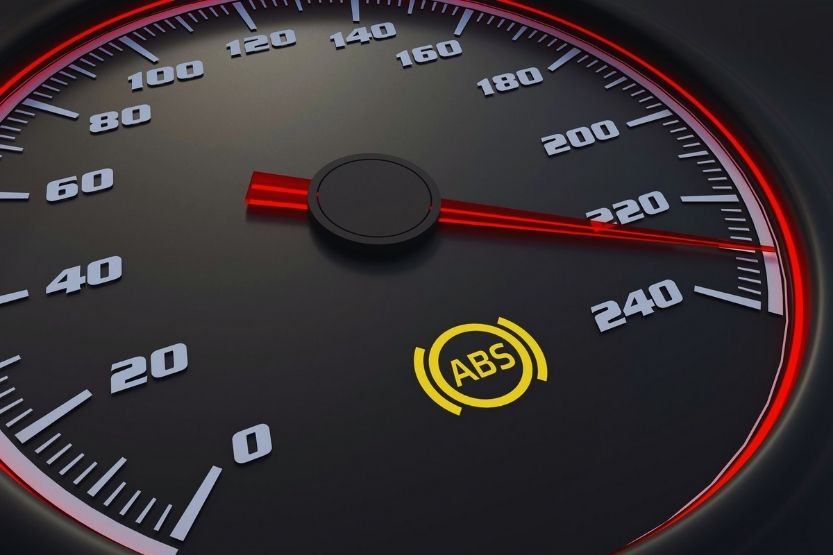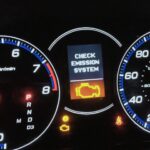The VSA system on your Acura TL functions to keep you safe while driving, but there might be some confusion as to what its corresponding lights mean. And when they stay on longer than they’re supposed to, it could be an indicator of a bigger problem. So, to avoid any mishaps due to misunderstandings, it is important to familiarize yourself with the Acura VSA Light – what is it?
The Vehicle Stability Assist, or VSA, is an automated driving system designed to keep you safe when driving under hazardous conditions. The VSA light on Acuras is an indicator light that lets you know that the system is activated, but if it stays on, there may be a problem with the VSA itself.
When the VSA light remains on, it means your TL needs attention to get the system running smoothly again by restarting the engine in a safe place.
Read on to learn more about VSA light on Acuras.
Acura VSA Light – What Is It?

The Vehicle Stability Assist, or VSA, is an automated driving system designed to keep you safe when driving under hazardous conditions. The VSA light (Acura) is a signal light that lets you know that the system is activated. However, if it stays on, there may be a problem with the VSA itself.
When the VSA light remains on, it means your TL needs attention to get the system running smoothly again by restarting the engine in a safe place.
Acura VSA Light Functions
The Vehicle Stability Assist (VSA) is an automated driving system that helps keep you in control when driving under less than ideal conditions that may occur anywhere. It has two main functions, which include the following:
- Cornering Control
- Traction Control
Let me briefly explain the two.
1. Cornering Control
The VSA helps keep you on course. It corrects oversteering or understeering to make sure that your vehicle remains going in your intended direction.
2. Traction Control
The VSA helps your Acura get the needed traction. This can be either by limiting the wheel slip rate or by lowering the engine speed.
When Does the VSA Light (Acura) Activate
Activated During Dangerous Circumstances
The VSA system frequently activates during dangerous circumstances. Typically, some of the causes include the following:
- Bad weather,
- Unwieldy roads, or
- A car driving too fast to make the corner.
Maintain Smooth Acceleration on Steep Slopes
This system also helps in maintaining smooth acceleration on steep slopes and slippery terrain. Its technology functions by automatically changing the engine’s output. It also functions by individually applying the brakes of each wheel to improve traction and keep the car under close driver control.
Check Emission System Acura Warning Light Causes
How to Turn the VSA System On and Off
Turns on When You Start the Car’s Ignition
Every time you start your car’s ignition, the Vehicle Stability Assist system turns on by default. This automatically happens even if you had switched it off the previous time that you drove your car. But then, why would anyone want to switch it off? The VSA is an important safety feature, after all.
Cases Where It Is Better to Turn Off the VSA System
However, there are certain situations where the VSA system can be more hindrance than helpful. For instance, if you find yourself struggling to drive up a fresh snow hill. This is due to the VSA decreasing the engine power and applying the brakes to slipping wheels. It leaves you with very little power to go uphill.
So, when you find yourself stuck in fresh snow or sand or shallow mud, you are much better off turning the VSA system off. That way, you can easily get your car-free. Just remember to turn the VSA back on when you resume normal driving.
Locate the VSA Off Button
If you wish to turn the VSA system off, try to find the VSA Off Button. It is located under the left vent of the steering wheel. When you press the button, a clear VSA OFF indicator light will come on the dash.
VSA Activation Light Blinking on the Console

Assists You to Steer Safely
If you notice that the VSA light on your console is blinking, it doesn’t necessarily mean that something is wrong. The blinking light only means that the VSA system has been activated and is assisting your car to steer safely.
Changes in Driving When VSA System Is on
While the system is in operation, you may notice certain changes in the handling, including the following:
- The accelerator may not be increasing the engine power as much as you would expect; and
- The engine output may decrease in power even if you didn’t lift the accelerator. Also, the brakes may be applied automatically, even though they shouldn’t be too sudden or noticeable.
If the VSA activation light stays on rather than blinking, it normally means that the VSA system has been disabled through the console switch. You would only need to turn the system back on to fix this.
What Does It Mean When VSA Warning Lights Turn on
Aside from the permanent VSA activation light, the system also comes with two warning lights that you need to pay particular attention to when they light up longer than they should. These are the following:
- VSA System Light
- Triangle with Exclamation Point
1. VSA System Light
This is the system indicator light that tells you if there is a problem with your VSA. Pullover and restart your engine. When the light doesn’t switch back on, then you fix the problem. Have a mechanic check your car when the light is still on.
2. Triangle with Exclamation Point
It may look like a warning sign, but this is not necessarily the case. When this light is on, it indicates that the VSA is currently activated and is keeping your Acura safe as you’re driving. But if it stays on at all times, there is a problem with the system.
To address this, find the button on the dashboard that says VSA and press it to see if the light switches off. If it remains on with the VSA light, then there is an underlying problem with the system.
Why the VSA System Stays on
A faulty VSA light equals a faulty VSA system, and it is not a problem that anyone should take for granted. It has no direct bearing on your driving, and you can safely drive your car even without the VSA. But if it isn’t working properly, then it won’t be able to keep you secure should you run into any hazards on the road.
Get a Reading of the Diagnostic Trouble Codes
To find out what exactly causes the VSA lights on your Acura to stay on, you would have to get a reading of the diagnostic trouble codes of your Acura. You can use a good code scanner, or you can have your Acura taken to a local parts store and ask them to scan it for you.
Scan the Engine, Steering, and ABS Control Units
If you decide to get a code scanner, note that the cheaper ones read only the engine. This is usually fine, but it can be possible that your VSA light problems come from one of the other control units. To be sure, you need to have the Engine Control Unit, the Steering Control Unit, and the ABS Control Unit to be scanned.
Again, what is an Acura VSA Light? The Vehicle Stability Assist (VSA) is an assisted driving system with a traction control system. Have an Acura dealer check the system to see if it stays on or comes back on while you’re driving. Usually, the VSA system malfunctions when you’re driving with varying tire or wheel sizes.
VSA Sensors

The VSA makes use of two sensors. These are the following:
- Steering Angle Sensor
- Anti-Lock Braking System (ABS) or Wheel Speed Sensor (WSS)
1. Steering Angle Sensor
The Steering Angle Sensor is used by the VSA to accurately determine whether or not your car is pointed in the precise direction you intend for it to go. If the VSA light comes on, it means that the sensor is not working properly.
2. Anti-Lock Braking System (ABS) or Wheel Speed Sensor (WSS)
The Anti-Lock Braking System or ABS, also known as the Wheel Speed Sensor or WSS, monitors and regulates the wheel speed.
If one of the wheels rotates slower than the others and does not synchronize with the steering angle, the VSA steps in to instantly correct it. It provides proper traction and control of your car.
There are times when the VSA light turns on, and it usually does along with the ABS light. This means that the WSS is not functioning properly. It is no longer sending a signal to the VSA system.
How to Reset the Anti-Lock Braking System (ABS) Module
Since the VSA system runs through the ABS, the ABS module is likely why the VSA light is coming on. In which case, you would need to reset it. If you have a serious problem with your brakes, make sure to have them repaired or replaced before resetting the ABS.
Here are the steps for resetting the ABS Module:
- Reset the Power to Your Vehicle’s Main Computer
- Change the ABS Sensor If the Light Comes Back On
- Use an OBD Code Reader
1. Reset the Power to Your Vehicle’s Main Computer
The first step is to reset the power to your car’s central computer. Do this by disconnecting the positive battery cable on your car’s battery. Then, hold down the brake pedal for some time until your car’s electrical system is drained.
The loss of stored electricity will cause the central computer to reset and turn off the indicator light. Then reconnect the positive battery cable to restore the power to your car. If the light remains off, then the ABS has been reset. But if it turns back on anytime within the week, proceed to the next step.
2. Change the ABS Sensor If the Light Comes Back On
If the light comes back on, you need to change the ABS sensor controlling the anti-lock brakes, which wear out as it ages and starts sending out false readings. The good news is that ABS sensors are cheap and are easy to replace.
You can find the ABS sensor inside a sensor housing screwed onto the wheel hub. All you need to do is unscrew the housing, unplug the sensor wire, and then replace the old ABS unit with the new one.
By now, you have reset the ABS lights. If not, repeat Step 1 and drain the power from the computer. If the light is still coming on, then move on to the third step.
3. Use an OBD Code Reader
If the problem persists, you will need to use an On-Board Diagnostics (OBD) code reader to determine what triggers the indicator lights. An OBD code reader will only cost you about $30, and it directly connects to your car’s system.
If you opt not to buy an OBD reader, you can take your vehicle to a car parts store and have the codes read for you there. The codes will determine what parts of your brakes need to be repaired or replaced to keep the indicator lights from turning back on.
Effect of Tire Sizes on the VSA System
The size of your tires is another factor that can affect the functionality of the VSA system. If you’re driving with varying wheel or tire sizes, it could contribute to the malfunction of your VSA.
When replacing tires, make sure that their size and type are the same as those of your previous tires. You should also turn off the VSA system if you’re driving with the compact spare tire installed.
If you are installing winter times, make certain that their size is the same as those originally came with your car. Remember to practice due caution when driving during the winter if you have left the VSA system off.
Conclusion – Acura VSA Light – What is It?
The Vehicle Stability Assist, or VSA, refers to an automated driving system designed to keep you safe when driving under hazardous conditions. The VSA light on Acuras is an indicator light that lets you know that the system is activated. However, if it stays on, there may be a problem with the VSA itself.
True to its name, the VSA is a system that makes sure that your Acura TL remains stable when driving through challenging terrain. As such, it is important to pay close attention to the designated VSA lights on your Acura to determine if the system is functioning properly.
Related reading:
“Check Gauge” Light – What Does It Mean?
Check Engine Light On and Off Intermittently [Causes and Fixes]
How Long Can You Drive with Check Engine Light On?
DRL Light – What Does This Mean?
How Reliable Is the Acura Brand?
Are Acuras Good Cars? [Problems, Reliability, Maintenance Costs]




![DRL Warning Light [What Does It Mean, Causes, and How to Fix] what does the drl warning light mean](https://roadsumo.com/wp-content/uploads/2022/04/what-does-the-drl-warning-light-mean-150x150.jpg)



![Read more about the article High Build Primer [When to Use and Best Automotive High Build Primers]](https://roadsumo.com/wp-content/uploads/2021/06/High-Build-primer-300x200.jpg)
